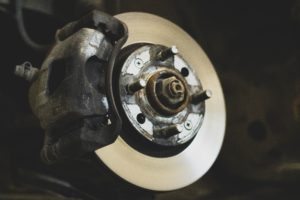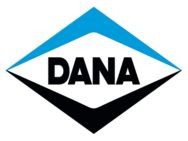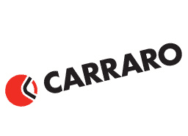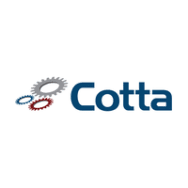Heavy equipment requires high-performance braking systems that withstand extreme thermal loads. But, more importantly, they should keep the brakes running cool. Three types of braking systems can be used depending on the specific industrial machine.
1. Industrial Caliper Brakes
A high-quality caliper brake is essential in industrial operations where frequent starting and stopping require high force.
Even in harsh conditions, WPT’s caliper brakes have proved dependable and require little maintenance. Its high productivity level is due to an anti-stress load transfer system working with a ductile iron saddle-frame design.
How the braking systems work:
A caliper brake acts like a clamp, squeezing brake pads to press on the disc brake, thus stopping or slowing down rotation.
Regulating the disc and shoe clearance is through levers controlling adjustable clevises on actuators. WPT incidentally engineered the actuators to use minimal air pressure while providing accurate brake torque control.
How it works in a caliper system:
- The disc brakes, which can be an axle, wheel or drum, are attached to the rotating mechanism of the equipment or machinery.
- Squeezing or releasing brake pads (usually by spring action) is done by controlling the ventilated rotor.
- The brake pads cause friction to slow down or stop rotations.
The two most common types of disc brake calipers are:
- Air-applied spring-release caliper braking system used for applications that require large amounts of torque.
- Spring-applied air-release caliper braking system with emergency or parking brake function for light-to-medium-duty torque.
Advantages of WPT Caliper Brakes
WPT industrial caliper disc brakes operate in demanding environments that require high performance and reliability. Their functions are beyond truck and car brakes and are more suitable for tensioning, static holding and stopping in winches for onshore and offshore operations, well-service rigs, and forestry.
Key Features:
- Uses standard non-asbestos friction material
- Reduced downtime and repair costs due to balancing links creating even wear
- Maximum airflow and energy dissipation through the use of vented rotors
- Semi-metallic brake pads are available if there is a need for higher torque applications
2. Water Cooled Brakes
Water-cooled braking systems can handle high levels of stress and strain. Specifically, this is due to water coolant circulating in the internal chamber of the cooling plate built into the central disc plate. Because of the ability to dissipate large amounts of heat, the common application of this braking system mainly lies in heavy equipment and machinery.
Water Cooled vs. Air Cooled Braking Systems
Many of the other types of braking systems are air-cooled, which relies on external air circulating to lessen heat buildup. In principle, the higher the temperature, the larger the air volume required to keep the brake from overheating.
Trucks and car brakes, by their usage, do not require large air volumes. There is also ample space between the brake and wheel hub. While air volume contributes to the physical size of an air-cooled brake system, it’s not a limiting factor.
Meanwhile, using air-cooled brakes on heavy equipment and machinery is not always an option, especially for those that produce large amounts of heat for long periods. In this case, the size of an air-cooled brake would be too large. As it is, space is not a luxury on industrial machines as their parts are densely packed. A water-cooled brake system, which is physically smaller, is thus more suited for the job.
Advantages of WPT Water Cooled Brakes
WPT water-cooled braking systems are air-actuated and cooled by liquid coolant circulating in an open or closed-loop cooling system. Liquid coolants are high-energy absorbing solutions that can withstand severe high-heat braking applications.
Key Features:
- Internal water flow and copper alloy wear plates designed for efficient heat dissipation.
- Built with a durable neoprene air tube does not need special coatings or treatments and is resistant to corrosion, thus ideal for harsh environments.
- O-rings design allows for fast, easy, error-free field service.
- WPT designed these brakes with removable shims for easy wear adjustments.
- Retrofit kits are available to convert a single or dual-piston actuated water-cooled brake to air tube actuation with no other modifications.
- Mounting hole patterns are standard for retrofits, rebuilds and OEM applications.
Applications
WPT water-cooled brakes are suitable for dynamic tensioning and static holding applications where there is a need for heavy-duty constant slip tensioning.
- Drawworks. WPT WCB can dissipate large thermal loads. They also allow precision control in static and dynamic braking conditions typical in well-service and drilling operations.
- Dynamometers. The air tube and hydraulic multi-piston radial actuators in WPT water-cooled brakes provide precision control over a wide range of torque. Moreover, their high-flow water jackets and copper linings can transfer energy quickly and efficiently.
- Marine Winches. WPT’s water-cooled brakes use copper wear plates that allow efficient heat dissipation in highly-demanding heave-in and payout mooring operations. In addition, a complete marine corrosion package for maximum protection in harsh marine conditions is available.
- Paper Converting. WPT’s precision torque, tension control, and consistent performance in maintaining friction temperature make it suitable for winding applications in paper mills.
- Coil Processing. Accurate tension control and excellent heat dissipation make WPT water-cooled brakes suitable for uncoilers, unwind stands, and slitters in metal processing applications.
- Yarders. In log yarder applications, slowing, stopping, or holding winch drum cables create a large thermal load. WPT water-cooled brakes, designed for continuous slip service, can consistently dissipate the heat generated.
3. Low Inertia Clutch and Brake
WPT’s low inertia clutch and brake solutions are suitable for high-cycle applications. During the start and stop operations, there are few part movements, while decreased acceleration time leads to higher cycles per minute. The most common applications of these clutches and brakes are in industries such as marine, oil and gas, grinding mills, and metal forming.
WPT low inertia clutch and brake are pneumatically-applied, spring-released, and used in equipment or machinery requiring end-shaft mounting. Among its key features are:
- Air pressure design allows for quick engagements and disengagements.
- Ventilated air flow allows the brake to run cool even in high-cycle applications.
- Adjustments are minimal once in operation.
- Engineered for controlled slipping and high-cycle operations.
- Predictable preventative maintenance provides for easier maintenance and higher life cycles.
Industrial Braking Systems for Heavy Machinery
A braking system serves the function of slowing down or stopping a component from moving (rotating). In heavy industries, heavy equipment and specialized machinery require a fast response and a stable torque at all times.
In industrial applications, the heat and strain generated are significant. For this reason, only industrial-grade brakes are acceptable due to their optimal performance. Generally, there are three types to choose from:
- Caliper brake
- Water-cooled brake
- Low inertia brake and clutch
If you want to know more about high-quality braking systems requiring accurate tension control, high brake torque, low inertia, and others, call 817.267.0129 to contact us or use this form.


























